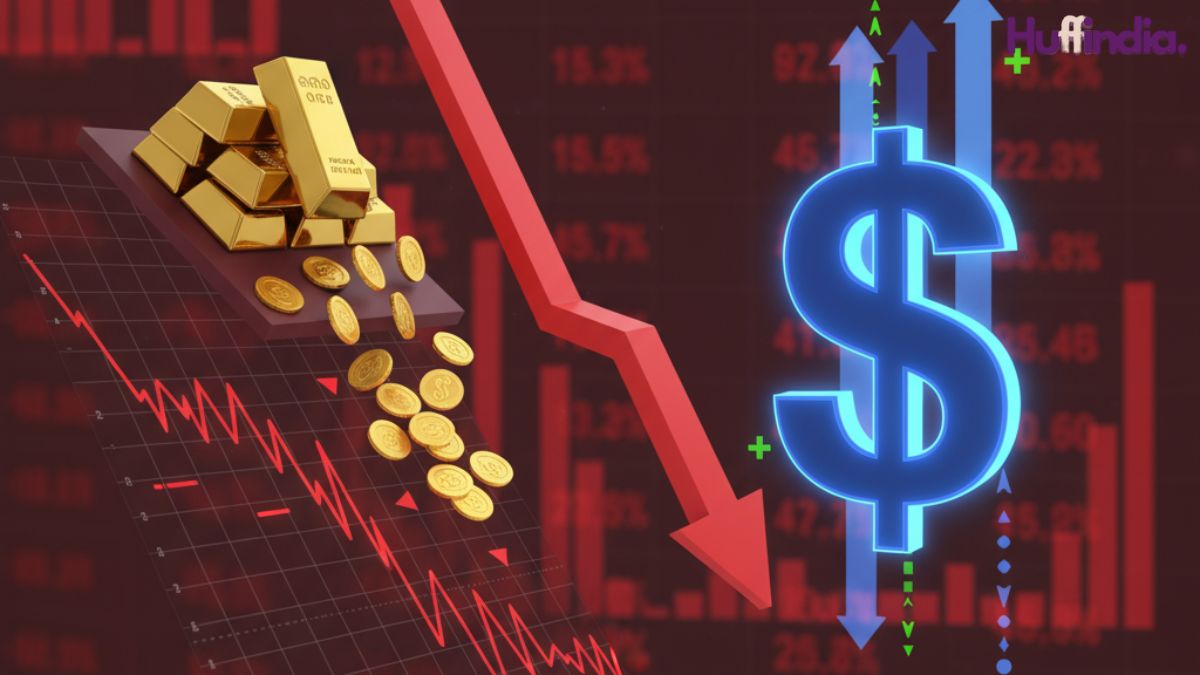Gold markets have witnessed a dramatic reversal as why gold prices are falling has become the pressing question for millions of investors globally. After achieving an all-time peak of $4,381 per ounce in October 2025, the precious metal experienced its most significant decline in over twelve years, plummeting 6.3% to break below the $4,000 psychological barrier.
The Immediate Market Reality
On October 21, 2025, why gold prices are falling crystallized into market reality when spot gold dropped sharply to near $4,000 per ounce during the trading session. December gold futures fell $29.90 to settle at $4,079.20, marking a historic breakdown for the precious metals complex. This collapse ended an impressive nine-week winning streak that had captured widespread investor attention and media coverage.
By October 24, gold prices stabilized around $4,110 per ounce, yet the damage to investor confidence persisted. The sharp reversal has left market analysts and investors searching for answers about what triggered such a dramatic about-face after months of relentless gains.
Primary Driver: Aggressive Profit-Taking
The foremost reason why gold prices are falling centers on profit-taking by institutional investors who accumulated substantial positions during gold’s extraordinary year-long rally. Gold-backed ETFs experienced their most significant single-day tonnage withdrawal in five months on October 21, according to market data from major commodity exchanges. This withdrawal signal indicated that sophisticated investors were locking in gains after witnessing remarkable price appreciation of approximately 57% year-to-date.
The rally had become technically overstretched, with gold forming a double-top pattern—a classic bearish technical formation that typically precedes price declines. When this pattern formed near $4,380, sophisticated traders recognized the setup and began reducing long positions aggressively. The cascade of selling accelerated as “gold tourists” (inexperienced investors who purchased during the euphoric phase) rushed to exit their positions as prices began declining.
Dollar Strength Reshapes the Landscape
A critical factor explaining why gold prices are falling involves the resurgence of U.S. dollar strength. Since gold is denominated globally in U.S. dollars, currency dynamics play a fundamental role in determining international demand. When the dollar appreciates, gold becomes more expensive for overseas buyers who must exchange their local currencies for dollars at less favorable rates.
The dollar index strengthened over three consecutive trading sessions preceding gold’s crash, creating significant headwinds for the precious metal. This currency movement directly reduces purchasing power for international investors in Europe, Asia, and emerging markets—precisely the regions where gold demand remains strongest.
Trade Tensions Ease, Risk Appetite Rebounds
Perhaps unexpectedly, improving geopolitical conditions have substantially contributed to gold’s decline. Gold thrives during periods of global uncertainty and crisis when investors seek safe-haven protection. However, when those fears diminish, demand for defensive assets like gold naturally contracts.
Recent diplomatic developments have shifted market sentiment positively. Reports indicating that President Donald Trump will meet Chinese President Xi Jinping in South Korea next week sparked optimism regarding potential U.S.-China trade resolution. Combined with Trump’s moderated rhetoric toward Beijing, market participants have significantly reduced their fears about escalating trade conflict. This shift from risk-off to risk-on positioning has accelerated capital reallocation from gold into growth-oriented equities.
Federal Reserve Policy Shifts Expectations
The Federal Reserve’s anticipated interest rate cuts are simultaneously supporting and challenging gold prices. Markets have priced in certainty regarding a 25-basis-point rate cut at the upcoming October meeting and another cut in December, according to CME FedWatch data. While lower interest rates typically benefit non-yielding assets like gold, the market already incorporated these expectations during gold’s rally phase.
Recent U.S. inflation data released on October 24 showed headline inflation at 3.0% in September, slightly above forecasts but reflecting moderating pressures. This data paradoxically weighed on gold by reducing inflation-hedging urgency while supporting the broader economic narrative and strengthening the dollar.
Looking Forward: Strategic Opportunities Emerge
While short-term volatility persists, the structural factors supporting gold—U.S.-China trade tensions, central bank demand, inflation concerns, and geopolitical risks—remain largely intact. Trading Economics analysts project gold reaching $4,300 by quarter-end, with twelve-month forecasts suggesting prices around $4,500. Gold remains approximately 55% higher year-to-date, ranking among 2025’s strongest asset performances.
Central banks worldwide continue accumulating gold reserves, with India’s central bank holdings exceeding $100 billion. This institutional demand floor provides underlying support for prices, suggesting that significant declines may attract strategic buyers seeking long-term portfolio diversification.
Conclusion
Why gold prices are falling represents a natural market correction following extraordinary gains rather than a fundamental breakdown in gold’s investment thesis. The convergence of profit-taking, dollar appreciation, and improved geopolitical sentiment created a perfect storm for precious metals bearishness. However, investors should recognize that this correction offers potential opportunities for those maintaining a long-term perspective.
For institutional and retail investors alike, gold’s role as a portfolio hedge against inflation, currency debasement, and geopolitical uncertainty remains compelling. The current dislocation between gold’s technical weakness and its strong fundamental underpinnings suggests that disciplined investors may find attractive entry points at depressed prices. While near-term volatility will likely persist, the multi-year investment case for gold exposure remains intact for those with patience and conviction in their long-term investment strategy.























